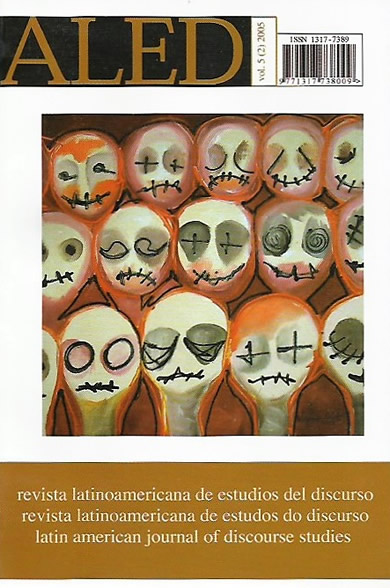Modalidades comunicativo-discursivas de participación en comunidades virtuales de aprendizaje
una propuesta para la evaluación formativa
DOI:
https://doi.org/10.35956/v.5.n2.2005.p.7-32Keywords:
learning community. instructional discourse. evaluation. internet.Abstract
Evaluation of the virtual communities’ participants learning is one of the most critical and less explored aspects of the instructional designs and activities on the Net, understanding the virtual communities as practice communities (Mercer, 2000). Although the technology allows documentation and quantification of the events in an exhaustive manner ”“the contributions in conferences, chats, e-mails, and work documets”“, these do not reflect on an adequate and qualitative way the discursive process and the real learning achievement, in relation with the instructional design as well as the external criteria of the quality of learning (Garrison & Anderson, 2003). When tutors evaluate the pupils’ participation, this action is usually reduced only to formal or quantitative aspects, because of the lack of interpretative skills for electronic discourse. The aim of this study, based on a corpus constituted of electronic conferences with Latinamerican participants, is centered on development and proposal of instruments of qualitative analysis and interpretation which allow on line teachers/tutors for incorporate different instructive design of on line formation in an effective and parsimonious manner.
Downloads
References
AUSTIN, J. (1971/1962) Cómo hacer cosas con palabras. Madrid: Paidós.BANZATO, M. (2002) Apprendere in rete. Torino: UTET.
BROWN, P. & LEVINSON, S.C. (1987) Politeness:Some Universals in Langua-gue Usage. Cambridge (UK): University Press.
BROWN G. & YULE, G. (1993) Análisis del discurso. Madrid: Visor.
BRUNER, J. (1984) Acción, pensamiento y lenguaje. Madrid: Alianza.
CAZDEN, C. (2001) Classroom discourse. Second edition. Porstmouth: Heine-mann.
CERRATTO, T. & WÆRN,Y. (2000) ‘Chatting to Learn and Learning to Chatin Collaborative Virtual Environments’, M/C: A Journal of Media and Cul ure 3, Nº 4, http://www.api-network.com/mc/0008/ learning.html (Consulta: julio 2001)
CHRISTIE, F. (2002) Classroom Discourse Analysis. Continuum: New York.
CLARK, C.R. & MAYER, R.E. (2003) E-learning and the science of instruction.San Francisco: Jossey-Bass.
COLLISON, G., ELBAUM, B., HAAVIND, S. & TINKER R. (2000) Facilita-ting Online Learning: Effective Strategies for Moderators. Madison: AtwoodPublishing.
CONSTANTINO, G. D. (2001) ‘Perfil de competencia para la formación onli-ne: una perspectiva comunicativa-discursiva’, en 2do Congreso Nacional de Investigación Educativa. Cipoletti: Universidad del Comahue.
CONSTANTINO, G. D. (2002) ‘Presenza vitale contro presenza virtuale: stu-dio contrastivo dei modi strategico-discorsivi della interazione didattica’,Apprendere in rete. Modelli e strumenti per l’e-learning. Torino: UTET, pp.218-262.
CONSTANTINO, G. D. (comp.) (2002a) Investigación cualitativa & análisisdel discurso en educación. Catamarca: Editorial Universitaria.
CONSTANTINO, G. D. (en prensa) ‘Discurso didáctico electrónico: los modosde interacción discursiva en el aula virtual en contraste con el aula presencial’. Linguagem em Discurso.
DAVIS B.H. & J.P. BREWER. (1997) Electronic Discourse. Linguistic Individualsin Virtual Space. New York: SUNY.
DENZIN, N.K. (1999) ‘Cybertalk and the Method of Instances’, en S. Jones,(ed.) Doing Internet Research. Critical Issues and Methods for Examining thenet.Thousand Oaks (CA): Sage.
FAIRCLOUGH, N. (1992) Discourse and social change. London: Polity Press.
GARCÃA NEGRONI, M.M. (1987) ‘Roles protagónicos y actos de habla’, en B.Lavandera, y otros, Cuadernos de Lingüística. Análisis sociolingüístico del discurso político (II), 37-68. Buenos Aires: Instituto de Lingüística-UBA.
GARRISON, D. R. & ANDERSON, T. (2003) E-learning in the 21st century.London (UK): Routledge-Falmer.
GERNSBACHER, MA, & GIVÓN, T. (Eds.) (1995) Coherence in spontaneoustext. Philadelphia, PA: John Benjamins.
HAVELOCK, E. (1995) ‘La ecuación oral-escrito: una fórmula para la mentalidad moderna’, en D. R. Olson y N. Torrance (comps.): Cultura escrita yoralidad. Barcelona: Gedisa, pp. 25-46.
MARTIN, J. R., & R. VEEL (eds.) (1998) Reading Science. London: Routledge.
MARTIN, J.R. & ROSE, D. (2003) Working with Discourse. Meaning beyond theclause. Continuum: New York.
MERCER, N. (2000) Words and Minds. How we use language to think together.London: Routledge.
OLSON, D.R. (1998) El mundo sobre el papel. El impacto de la escritura y lalectura del conocimiento. Barcelona: Gedisa.
ONG, W. J. (1993)Oralidad y Escritura. Tecnologías de la Palabra. México: FCE.
OSTRIA GONZALEZ, M. (2001) Literatura oral, oralidad ficticia. Estudios filosóficos [online]. 2001, no.36, p.71-80. Disponible en la World Wide Web: . ISSN 0071 1713.
PALLOFF, R. & PRATT, K. (2001) Lessons from the cypberspace classroom. Therealities of online teaching. San Francisco: Jossey-Bass.
PALLOFF, R. & PRATT, K. (2003) The virtual student. A profile and guide toworking with online learners. San Francisco: Jossey-Bass.
PARDO, M. L. (1996) ‘El texto híbrido: una ejemplificación a través de la tele-novela latinoamericana’, Versión, pp. 139-148.
PARDO, M. L. (2002a) ‘Estado del área básico para una introducción al AD y alACD’, en G. D. Constantino. Investigación Cualitativa & Análisis del Dis-curso en Educación. Catamarca: Universitaria.
PSATHAS, G. (1995) Conversation analysis. Thousand Oaks (CA): Sage.
SALMON, G. (2000) E-moderating. The key to teaching and learning online. London: Kogan Page.
SCHANK, R. C. (2002) Designing world class e-learning. New York: McGrawHill.
SEARLE, J. (1986/1969) Actos de habla. Madrid: Cátedra.
VAN DIJK, T. A. (1996/1980) Estructuras y funciones del discurso. México: SigloXXI.
WENGER, E. (2001/1998) Comunidades de práctica. Aprendizaje, significado eidentidad. Buenos Aires: Paidós.
ZOPPI FONTANA, M.G. (1986) ‘El discurso referido o en busca del contextoperdido’, en B. Lavandera, Cuadernos del Instituto de Lingüística. Análisiss ociolingüístico del Discurso Político (I), 95-116. Buenos Aires: Instituto deLingüística-UBA
Downloads
Published
How to Cite
Issue
Section
License
Copyright (c) 2020 Gustavo Daniel Constantino

This work is licensed under a Creative Commons Attribution-NonCommercial-NoDerivatives 4.0 International License.
The authors retain the copyright and guarantee RALED the right to be the first publication of the work as well as a Creative Commons Attribution License that allows others to share the work with recognition of authorship and the initial publication in this journal.




